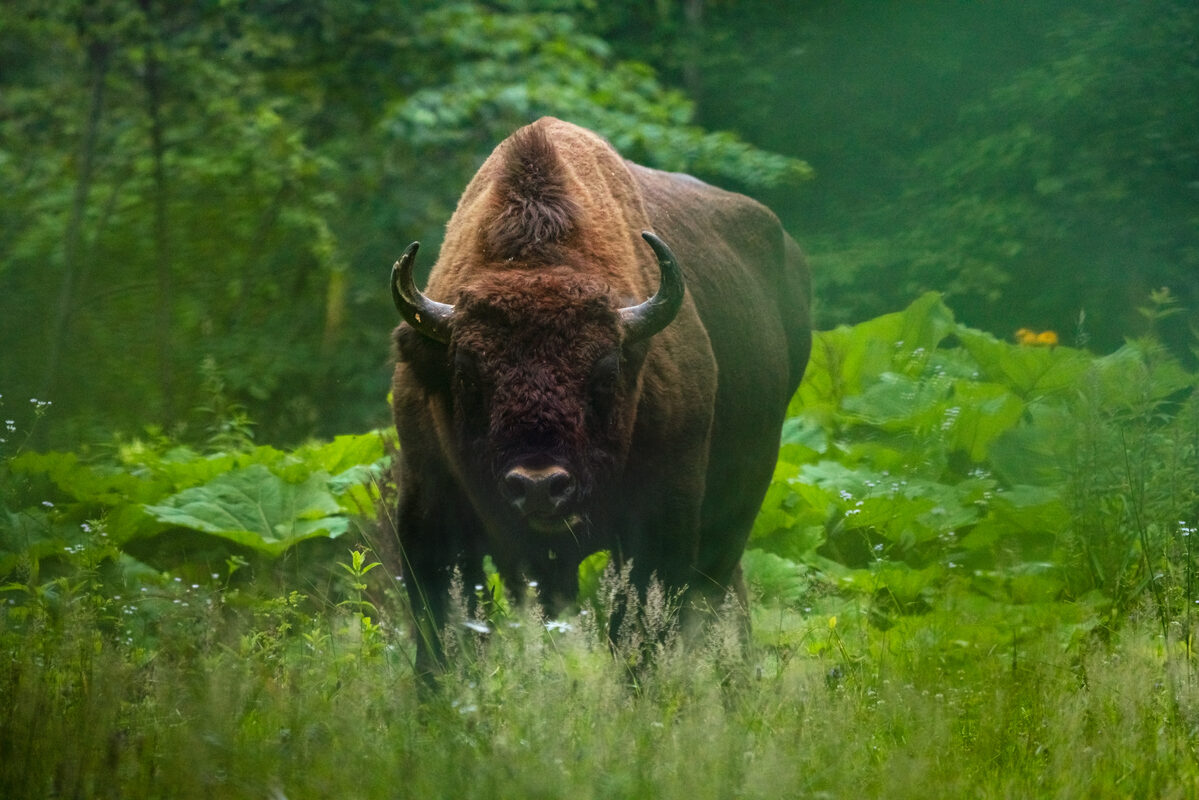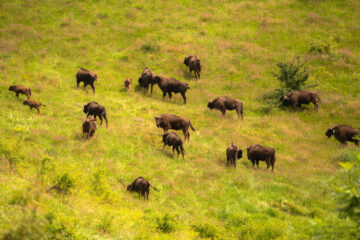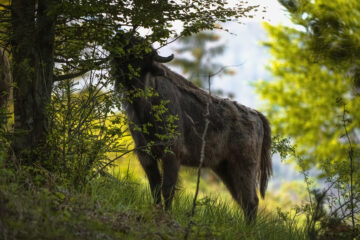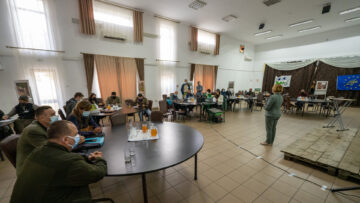The success of the LIFE RE-Bison initiative means Romania’s largest herd of wild European bison now roams free in the Southern Carpathians. As bison rewilding in the area moves into a new phase, the future of this important animal looks bright.

A platform for growth

Rewilding Europe and WWF Romania have been working to reintroduce European bison in the Southern Carpathians since 2014 – with the European Union’s LIFE programme providing invaluable support between 2016 and 2021, through the LIFE RE-Bison initiative. Over this timeframe rewilding efforts have generated some impressive results, with a herd of over 100 bison – the largest of its kind in Romania – now roaming free in the area and naturally increasing in size.
Nature moves to its own rhythms and timescales, which is why rewilding will always be a long-term commitment. With the LIFE RE-Bison initiative ending in September, the existing bison herds will now be allowed to breed naturally, creating a viable population that supports a thriving wild nature and local-nature based economy. If needed, further releases may be carried out to increase the population to a minimum viable level (150 animals).
Moving forwards
The second bison rewilding phase will include continued management and monitoring of the existing bison population to keep animals safe and healthy, as well as efforts that enable local people to derive even greater benefit from bison presence. This will include DNA and parasitological monitoring to prevent issues such as disease outbreaks and high levels of inbreeding. A stakeholder network will be created to enhance bison monitoring and keep human-bison relations harmonious.
The rewilding team will also focus on improving the legal framework for bison reintroduction and management, and set up a management model for the species. They will propose a national action plan for European bison conservation and a national conservation strategy for European bison to the Romanian Ministry of the Environment, as well as a clear procedure for the management of free-ranging bison populations.
Successful acclimatisation

The LIFE RE-Bison initiative saw a total of 14 bison transports carried out in collaboration with 32 breeding centres and reserves across Europe. This enabled the team to refine the reintroduction process and give the animals the best chance of successfully adapting to the wild after their release.
“By taking into account the age, gender and genetic background of bison, allowing the animals to form groups before their translocation, and selecting the best companies to handle the transports, we were able to increase the chances of survival,” says Rewilding Southern Carpathians team leader Mariana Drugă. “The fact that nearly 40 calves were born in the wild between 2016 and 2021 shows that the animals are acclimatising well, that the habitat is favourable, and that the species can successfully recover.”
The lessons learned over the course of the last six years have helped in the formulation of the LIFE RE-Bison Best Rewilding Practice Guidelines. These will guide and support other bison rewilding initiatives as they work to reintroduce Europe’s largest living land mammal into other landscapes.
Beneficial impact

The reintroduced bison herds in the Southern Carpathians are continually monitored by rangers in the field using the newest technology. Nearly 30 animals have been fitted with GPS collars during the initiative – this allows them to be tracked and virtual fences established around fields, hamlets and orchards to prevent damage. The data collected from the collars shows that the reintroduced bison have covered an area of nearly 90 km2, of which just over 18 km2 are used intensively.
As the bison population continues to grow it is having an increasingly positive impact, both in terms of local wild nature and the communities living in and around the rewilding area. The presence of this iconic keystone species is benefitting an array of other animals and plants and enhancing the functionality and resilience of local ecosystems. It is also driving the development of a thriving nature-based economy, complete with growing economic opportunities for local communities, and strengthening the connection between people and the resurgent nature around them. More details of this impact can be found in the first of the impact stories published to coincide with Rewilding Europe’s tenth anniversary.
Layman’s report
A recently published layman’s report provides a detailed breakdown of the individual measures carried out as part of the LIFE RE-Bison initiative, and its successful outcomes. These relate to the growth of the bison population and efforts to maintain harmonious and beneficial relations between the animals and local communities.
“Each success has been the product of hard work in the field, much research, strong collaboration between partners, and a determination to overcome the challenges posed by gaps in legislation, related to both the reintroduction of bison and their post-release management,” says Orieta Hulea, Director of WWF Romania.
Collaborating for the future

An event held in the village of Armeniș (part of the Southern Carpathians rewilding area) on September 23 and 24 brought all the partners in the LIFE RE-Bison initiative together. The group discussed the initiative’s results and challenges, as well enjoying a bison tracking experience. Representatives of the Ministry of Environment, the National Forestry Agency – Romsilva, the National Agency for Protected Natural Areas – Caraș-Severin Territorial Service, the Caraș-Severin County Forest Guard, the Sanitary Veterinary and Food Safety Directorate of Reșița, the Teregova Forestry School and the Municipality of Armeniș, the Vânători Neamț Nature Park, the Porțile de Fier Nature Park, the National Parks: Domogled – Valea Cernei, Semenic, Cheile Nerei – Beusnița, Conservation Carpathia Foundation, USAMV Cluj-Napoca, schools of Armeniș and Teregova, and members of the press all attended.
“The wide-ranging participation shows that interest in bison rewilding has increased at both a local and national level,” says Orieta Hulea. “We now need to develop a unified strategy that builds on what have achieved so far.”
All in all, the future for European bison in the Southern Carpathians looks promising. Supported by the ongoing efforts of the rewilding team, this impressive and influential animal should continue to benefit the wild nature and communities of the area on a growing scale, contributing to the overall recovery of the species in Europe.
